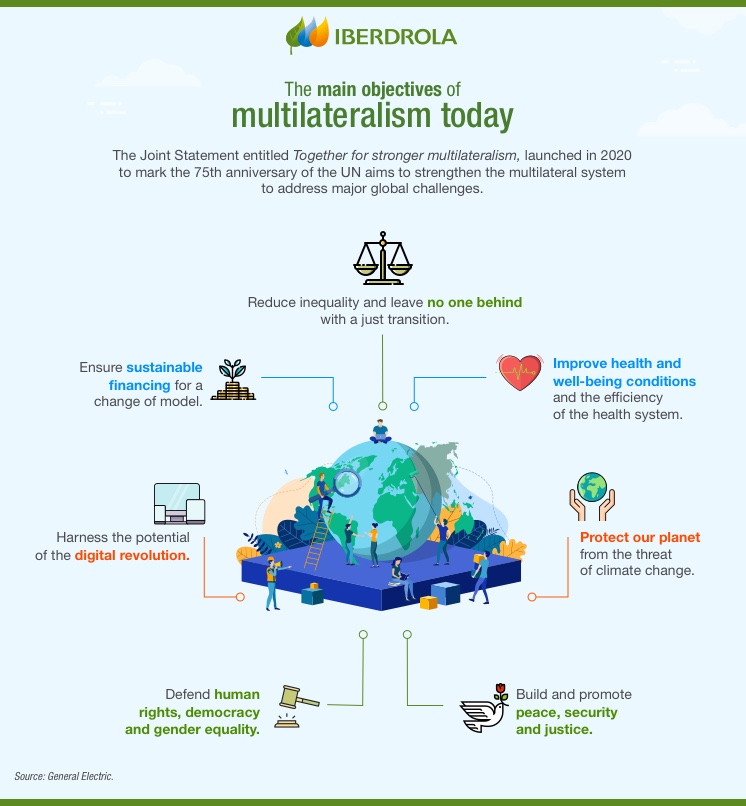What is multilateralism
Multilateralism, the most effective way to fight climate change
The fight against climate change is the biggest challenge facing humanity and in order to achieve success it requires the participation of everyone, from every citizen to every government. In a world that prioritises economic interests over environmental ones, for example, multilateralism will play an essential role in bringing countries together and establishing a common strategy with one goal: safeguarding the planet.

There is strength in numbers. Today, as the world is ravaged by the COVID-19 pandemic and threatened by climate change, this saying has never been so relevant since the Second World War. It was precisely in the aftermath of that conflict that the most important multilateral collaboration in modern history emerged: the Bretton Woods Agreement which had the prevention of another world war as its aim. In this context, multilateralism in favour of a Green Recovery and a commitment to climate change mitigation and adaptation is once again the best hope.
Multilateralism: meaning and importance
While unilateralism is when one country acts alone and bilateralism is when two countries work in partnership, multilateralism is usually defined as collaboration between several countries in pursuit of a common goal, where other parties such as civil society or the private sector may also be involved.
"We need a multilateralism where the voice of youth is decisive in shaping our future"
António Guterres, Secretary-General of the United Nations (UN
As we have already mentioned, multilateralism is more relevant today than ever. And not just to combat the pandemic, but to address the fight against climate change. This is acknowledged by António Guterres, Secretary-General of the United Nations (UN): "We need a networked multilateralism, where coordination between global organisations is strengthened and regional organisations are able to make their essential contribution; and an inclusive multilateralism, based on intensive interaction with civil society, business and other stakeholders".

SEE INFOGRAPHIC: The main objectives of multilateralism today [PDF]
What are multilateral organisations. Examples
Multilateral organisations are, as their name suggests, organisations made up of three or more partner countries with the aim of working together to solve common problems or to create favourable circumstances for all members. Today's main multilateral bodies include:
- United Nations (UN): officially established in October 1945, the UN is currently composed of 193 countries and its role is to take action on the problems facing humanity. These include the maintenance of peace and security, sustainable development, human rights humanitarian emergencies, gender equality, etc.
- World Health Organization (WHO): founded in April 1948 on the principle that health is a human right and that everyone should enjoy the highest attainable standard of health, defined as "a state of complete physical, mental and social well-being and not merely the absence of disease or infirmity".
- Organisation for Economic Cooperation and Development (OECD): Founded in 1961 as the successor to the Organisation for European Economic Co-operation, itself a successor to the Marshall Plan, the OECD is an international organisation and its goal is to shape policies that foster prosperity, equal opportunities and well-being for all.
In addition to these, there are dozens of organisations that, from a multilateral perspective, ensure that the majority of the planet joins forces. For example: the World Bank (WB), the International Labour Organization (ILO), the United Nations International Children's Emergency Fund (UNICEF), the Food and Agriculture Organization (FAO), the United Nations Development Programme (UNDP), etc.
Climate multilateralism: main multilateral environmental agreements
Climate change is a problem that affects the whole of humanity and, as such, requires collaboration from everyone: governments, businesses, civil society, etc. In a globalised and connected world, the boundaries between responsibilities are more blurred than ever and unilateral solutions are doomed to fail.
According to the WB's Groundswell Report, climate change could force more than 140 million people in sub-Saharan Africa, South Asia and Latin America to move within their countries' borders by 2050. But climate migration is only one of its many consequences. In addition, we have water scarcity, extreme weather events and loss of biodiversity. All of them represent serious threats to global stability that require global partnerships. In this regard, the main recent multilateral environmental agreements include:
Kyoto Protocol
already completed and the subject of criticism as to its actual effectiveness, it is considered a milestone of environmental multilateralism as it represents, since its adoption in December 1997 (although it did not enter into force until 2005), the first global commitment to slow down greenhouse gas (GHG) emissions, paving the way for the adoption of future agreements.
2030 Agenda for Sustainable Development
Adopted by the UN in September 2015 Agenda 2030 is made up of 17 Sustainable Development Goals (SDGs) that include specific references to environmental issues linked to other priorities such as poverty and hunger reduction, health, education, gender equality, etc.
Paris Agreement
Adopted in December 2015 in the framework of COP 21, is the first universal and legally binding agreement on climate change. Its main objective is to keep the global temperature increase below 2ºC with respect to pre-industrial levels, aiming to limit it to 1.5 ºC.




